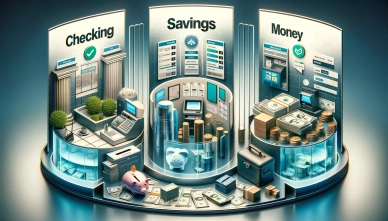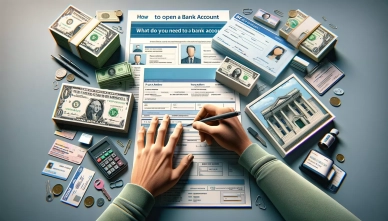How to Open a Bank Account: A Step-by-Step Guide

In a world of cashless payments and wireless transfers, a bank account is an immediate necessity for anyone. Protecting your funds from theft and loss, it serves as a secure space to deposit, withdraw, and manage money. Besides, opening a bank account grants you access to a wide range of financial services and tools, such as debit cards, online banking, and mobile apps, to simplify your transactions and easily control your finances.
Whether it's your first banking experience or you're looking to switch banks, this guide will provide detailed instructions on how to open a bank account.
Step1: Select an Account Type
Before you ask yourself, “What do I need to open a bank account?” you should first make up your mind on the type of account you want to set up. There are two main options available for you: checking and savings accounts.
Checking accounts are designed for daily transactions, including deposits, withdrawals, and payments. They offer easy access to funds through checks, debit cards, and ATMs. Typically, they come up with no or lower interest rates yet may have monthly service fees.
As the name suggests, savings accounts are meant to save money over time. Featuring higher interest rates than checking accounts, they are designed for less frequent withdrawals to encourage savings.
For more complex financial needs, you can consider a money market account, a hybrid combining features of both checking and savings accounts. Allowing for limited check writing and debit card use, it offers competitive interest rates, often tiered based on the account balance.

To decide which type of account best suits your needs and expectations, carefully evaluate your financial goals, spending habits, and saving objectives. A few key factors to consider when making your final choice include:
- Location and Accessibility: Consider the bank's physical locations and ATMs. Is there a branch near your home or workplace? Do they have an extensive ATM network? Accessibility is vital for your convenience;
- Fees and Charges: Different banks have varying fee structures. Look out for monthly maintenance fees, ATM fees, overdraft charges, and any other payments associated with the account. Some financial institutions ensure fee waivers based on factors like minimum balances or account activity;
- Interest Rates and APY: If you're considering a savings or money market account, pay attention to the interest rates offered. Annual Percentage Yield (APY) is a crucial metric to compare, as it reflects the total return you can expect on your deposit;
- Service Level: Check for additional services provided by the financial institution to enhance your banking experience. Mobile apps, functional online banking, and efficient customer support are all useful tools in this case.
Step 2: What Do You Need to Open a Bank Account?
Whether you wonder how to open a new bank account or how to start a bank account in yet another financial institution, you’ll need to provide specific documentation and personal information to verify your identity and comply with regulatory requirements. This step ensures that the bank can establish a secure and legal relationship with you as a customer.
- Government-Issued Identification: It can be any official document that includes your photo and personal information, such as a driver's license, passport, or national ID card;
- Proof of Address: This can be in the form of a utility bill (electricity, water, gas), a lease agreement, or a government-issued document like a tax return or voter registration card;
- Social Security Number (SSN) or Tax Identification Number (TIN): It’s essential to provide one of these docs for tax reporting and to comply with anti-money laundering (AML) regulations;
- Initial Deposit: Depending on the bank and the type of account, you may need to make an initial deposit to open the account.

Before visiting the bank, make sure that your identification documents are up-to-date and not expired. Different institutions may also have specific requirements, so you’ll also need to check them beforehand. It's a good idea to call or visit the bank's website to get a comprehensive list of what they expect from applicants.
Step 3. Set Up the Bank Account
Once you've gathered the required documents and information, it's time to submit your application. In most cases, when considering how to create a bank account, you’ll have two options. You can either apply online from the comfort of your own home or visit a physical branch in person.
How to Set up a Bank Account Online
On the website of the chosen bank, locate the application form and select the desired account type. Complete the form and upload scanned copies of documents as required. Review the info to ensure all details are correct. Then, submit the application electronically. The bank will typically provide a confirmation message or email with details about the next steps.
How to Open a Bank Account In-Person
Locate a nearby branch of the bank and ask a financial representative to help you pick the account type and guide you through the application process. You will have to fill out the application form, and the bank rep will make copies of the required documentation for their records. Once the application is complete, the bank representative will confirm the details and provide any additional information you may need.

Step 4: Get Started
When you receive confirmation from the bank that your application is approved, it’s time to fund your new account. You can do it through:
- Cash deposit in the bank branch or via an ATM;
- Check deposit in the bank or mobile app;
- Wire transfer from another bank or individual;
- Transfer from your other account.
Final Thought
Opening a bank account is a significant step toward financial well-being. It provides security and accessibility to your funds, along with a range of tools to manage and grow your money effectively. Besides, it helps build solid credit and financial history.
FAQ
What are the advantages of having a bank account?
Opening a bank account provides you with financial convenience and security. While securing your cash from physical theft, you can use it as you need and manage it efficiently.
How do I choose the best bank and account type for me?
When you look into how to make a bank account work for your immediate needs and long-term financial plans, you should estimate your current financial situation as well as consider your financial goals.
What documents and information do I need to open a bank account?
You’ll need to provide your personal info, including your address and SSN, and documents to verify your identity, such as a passport, ID card, or driving license.
